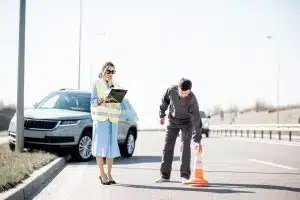24 Jul Top Causes of Fleet Accidents and How to Prevent Them
Accidents happen on all roadways with vehicles. Yet, when an accident impacts a vehicle within a fleet, that commercial organization now is not only limited in their access to the vehicle, but that depresses revenue production, creates hassles for drivers, and may impact relationships with customers. Recognizing the most common causes of fleet accidents is one of the first and most important steps in minimizing risk. With some insight, it is then possible for companies to take action to minimize avoidable, costly fleet accidents.
Causes of Fleet Accidents
What’s behind them?
Numerous potential causes exist, but some are more common than others that provide an opportunity for improvement.
Tired Drivers 
Driver fatigue is one of the most common causes of fleet accidents. While there are laws in place to minimize these risks by requiring specific periods of time off, that doesn’t mean your driver is getting the rest they need to avoid accidents.
Long work hours, long routes, and sleep deprivation impact drivers, causing them to have limited focus on the roadway. Fatigue also depresses reaction times, positioning a person to be unable to respond to fast-changing circumstances on the roadway.
Distracted Driving
Any time that something else is occurring within the vehicle, there is a risk of distraction. There are many potential causes of fleet accidents in this area, including:
- Talking on the phone while driving
- Having a heated discussion with someone else in the vehicle or on the phone
- Eating while driving
- Utilizing GPS and other navigation tools while driving
- Texting while driving
Many drivers will not routinely engage in these tasks. It takes just one instance, though, of distraction to cause a fatal and catastrophic injury and damage to vehicles.
Speeding
Rushing from one destination to the next may optimize hours on the road, but it also puts drivers at risk along with entire fleets. A fleet accident is more likely to happen when a driver is speeding because they have to be able to react to changing circumstances faster to stop the vehicle soon enough. Speeding also increases the risk of more damaging accidents, which can mean a higher risk of injuries.
Breaching of Traffic Rules
Traffic rules are typically in place to minimize the risk of accidents and keep all drivers on the roadways safe. Yet, there are many instances in which this doesn’t happen. For example, a driver that runs through a yellow light that’s turning red is more likely to strike another vehicle or a person crossing the road. A driver that doesn’t alert others on the roadway to changing lanes is more likely to cause an accident.
When drivers are not operating their vehicles according to expected roadway standards, that puts everyone on the road at risk. It increases the risk of accidents occurring while also enhancing the risk of those accidents causing catastrophic losses.
Poor Maintenance
Poorly maintained vehicles put every driver at risk that is on the roadway with that vehicle. That includes risks associated with tire blowouts, breakdowns due to engine failure, malfunctioning lights and horns, and countless other tasks. This is one of the most devastating losses because it can nearly always be avoided with careful planning.
A fleet accident may be avoided simply by completing routine maintenance that finds problems and allows for fast repair. It also helps ensure the vehicle and driver can operate in the safest way possible.
Solutions to Reduce the Risks of Accidents
Fleet managers can incorporate numerous tools and strategies to help them with reducing these risks. First, consider where you stand. What is a fleet accident capable of doing to your fleet right now? Will it mean customer frustration and loss, inactive drivers, or financial loss? If so, you need to incorporate these solutions.
Implement Safety Programs
Awareness is one of the most important resources companies have to reduce accidents. Safety programs allow for a fleet manager to guide and support drivers into being the safest they can be. This includes considering all factors that impact their ability to drive safely, like weather conditions, habits they have, and reckless driving. By having a fleet safety program in place, fleet managers can teach safe driving habits, defensive driving tactics, and new strategies.
Fleet accident and driver safety management not only reduces the risk of each of the most common causes of fleet accidents, but it also empowers managers to have the means to “do something” about changing circumstances with driver pools.
Focusing on Driver Education

To minimize the amount of time such educational programs can take, organizations can consider the implementation of web-based driver training programs as well as behind-the-wheel programs that enable companies to facilitate education in ways that work for their drivers. That can increase the success of such programs by simply making them more accessible to drivers.
Increase Awareness
Drivers know they need to be safe, but they don’t always recognize the true risks they face because it hasn’t happened to them yet. Raise awareness within your fleet of the cause of fleet accidents, including those related to speeding, distraction, and other preventable causes. Raising the awareness your drivers have of maintenance issues and not avoiding routine tasks can also drive safety.
Investing in Technology and Proper Maintenance for Improved Safety
Incorporating a fleet maintenance management system that utilizes available technology can provide an excellent resource to companies in reducing the frequency and severity of fleet accidents. Technology can be one of the best decisions organizations make in shoring up their risks.
For example, web-based fleet management systems enable companies to gain visibility into their vehicles and operations. They provide solutions for monitoring driver behavior and creating real-time mobile response tools.
For example, Fleet Response offers a comprehensive web-based fleet management system that is designed to provide clear improvement in fleet safety. It offers:
- Visibility: Through a web-based portal, companies get real-time access to their fleet’s data as well as analytics to consistent monitoring factors such as maintenance and fleet safety.
- Driver History Profile: This tool provides a way to monitor drivers and the risks associated with them. It offers scoring, profiling, and integration of claims as well as other violations. It can also incorporate online driver safety training. The benefit is that fleet managers have a clear picture of just how safe their drivers are.
- Driver Qualification File Management: This component creates a way to manage files that include medical and licensing information for drivers, motor vehicle record tracking, and tracking of all violations.
What Can Companies Do Now?
Every fleet is faced with an ongoing risk management goal. The key is to:
- Recognize that risks are present
- Many of those risks are preventable with the right strategies in place
- Driver education and skill are behind nearly all of the most common causes of accidents
- Raising awareness and empowering drivers and fleet managers lowers costs for companies
- Technology can make sure that the process is efficient and consistently managed
No matter the size and type of company you have, creating a driver safety program and putting the focus on fleet accidents and driver safety management is essential. It helps to save your organization money, protects client relationships, and builds a stronger, more trusted team of drivers.
Empower Your Fleet Today
Contact Fleet Response to learn more about the strategies available to you today to recognize the risk of fleet accidents risks and to put in place a technological solution that enhances the way you operate your business. Book an appointment with us now to learn what you can do today.





